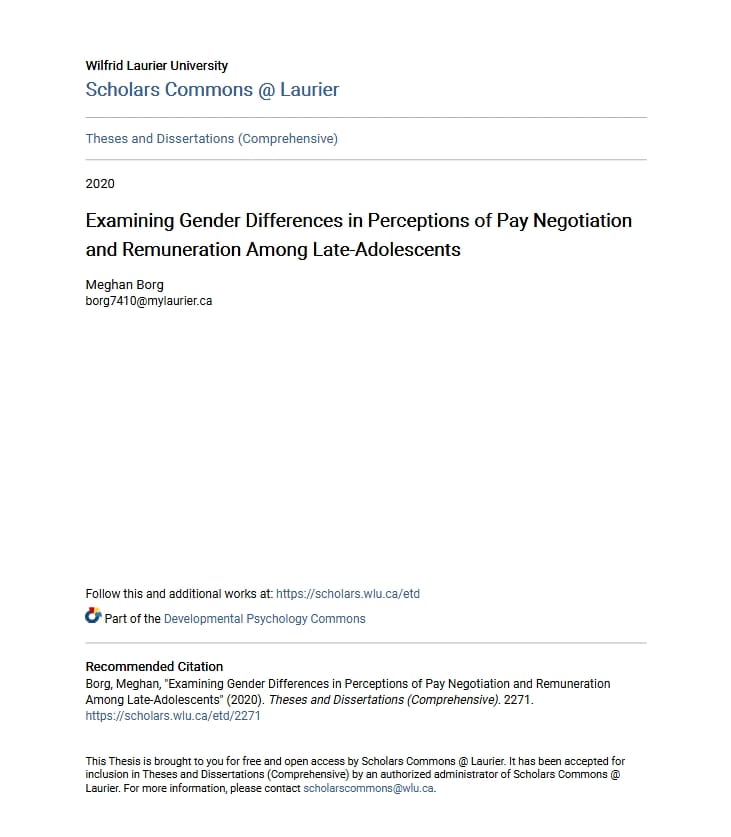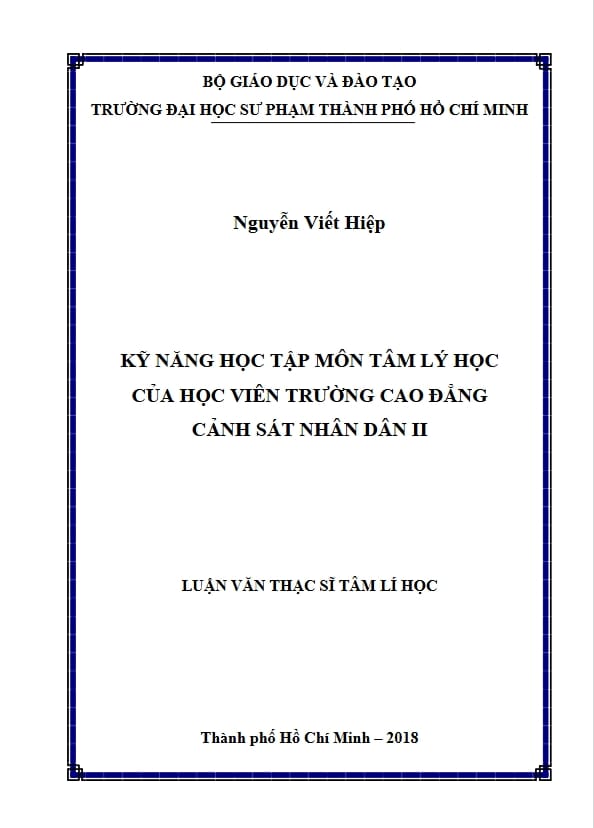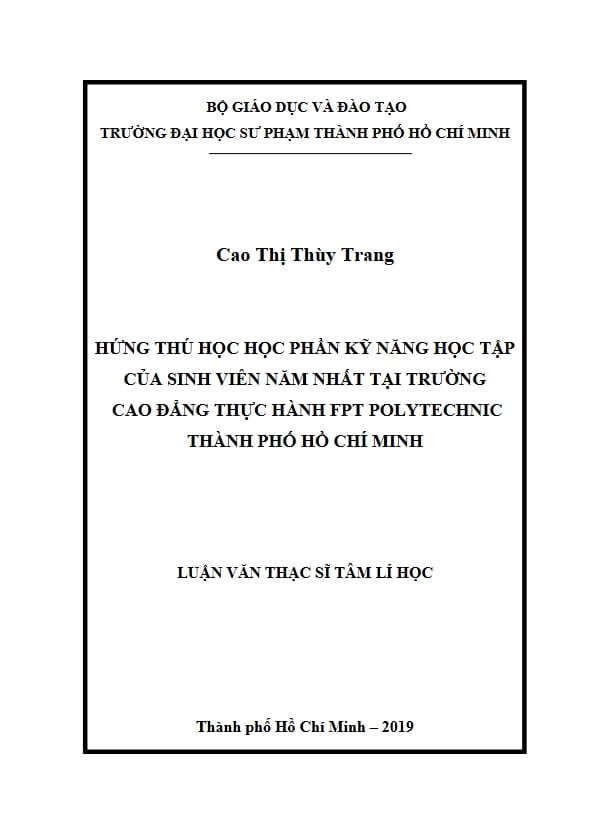Table of Contents
Abstract…………………………………………………………………………………………………………………………. i
Acknowledgements ……………………………………………………………………………………………………….. ii
Table of Contents …………………………………………………………………………………………………………. iii
List of Tables ………………………………………………………………………………………………………………. vii
Introduction ………………………………………………………………………………………………………………….. 1
Gender Pay Gap in Canada …………………………………………………………………………………………… 2
Global Gender Disparity ………………………………………………………………………………………………. 4
Sources of Financial Literacy Across Development …………………………………………………………. 6
Family socialization. ………………………………………………………………………………………………… 7
Educational socialization. …………………………………………………………………………………………. 9
Effectiveness of financial socialization. ……………………………………………………………………. 11
Early Paid Work Experiences ……………………………………………………………………………………… 11
Perceptions of and Experiences with Negotiation for Pay……………………………………………….. 12
Purpose of Current Study ……………………………………………………………………………………………. 15
Research Questions and Hypotheses ……………………………………………………………………………. 16
Method ……………………………………………………………………………………………………………………….. 17
Participants ……………………………………………………………………………………………………………….. 17
Materials ………………………………………………………………………………………………………………….. 19
Demographic information. ………………………………………………………………………………………. 19
Endorsement of feminine and masculine personality characteristics. ……………………………. 19
Career studies knowledge. ………………………………………………………………………………………. 20
Paid work experience. …………………………………………………………………………………………….. 22
Formal and casual paid work experience. ………………………………………………………………….. 22
Comfort asking for money. ……………………………………………………………………………………… 24
Negotiation experience. ………………………………………………………………………………………….. 24
Perceptions of negotiation……………………………………………………………………………………….. 25
Gender and negotiation scenarios. ……………………………………………………………………………. 26
Procedure …………………………………………………………………………………………………………………. 28
Results ………………………………………………………………………………………………………………………… 29
Preparedness for the Workforce…………………………………………………………………………………… 29
Perceptions of readiness. …………………………………………………………………………………………. 29
Sources of information. …………………………………………………………………………………………… 31
Wage knowledge. …………………………………………………………………………………………………… 32
Formal Work Experience ……………………………………………………………………………………………. 33
Remuneration for formal work. ……………………………………………………………………………….. 33
Casual Work Experience…………………………………………………………………………………………….. 34
Remuneration for casual work. ………………………………………………………………………………… 34
Disposable income. ………………………………………………………………………………………………… 35
Gender Typing of Jobs ……………………………………………………………………………………………….. 35
Formal work. …………………………………………………………………………………………………………. 35
Casual work. …………………………………………………………………………………………………………. 36
Personal Attributions of Gender-Typed Personality Characteristics …………………………………. 36
Negotiating for Pay ……………………………………………………………………………………………………. 37
Perception of Pay-for-Performance ……………………………………………………………………………… 38
Beliefs and Exposure to Negotiation for Pay …………………………………………………………………. 39
Experience with Negotiating for a Higher Wage ……………………………………………………………. 40
Perceptions of Negotiation ………………………………………………………………………………………….. 41
Gender Differences in Perception of Success of Negotiation Strategies ……………………………. 42
Collaborative negotiation strategy. …………………………………………………………………………… 42
Gender-typing of the negotiator using a collaborative strategy …………………………………. 42
Perceptions of success of a male negotiator using a collaborative strategy ………………… 43
Perceptions of success of a female negotiator using a collaborative strategy ……………… 44
Competitive negotiation strategy. …………………………………………………………………………….. 45
Gender-typing of the negotiator using a competitive strategy …………………………………… 45
Perceptions of success of a male negotiator using a competitive strategy ………………….. 46
Perceptions of success of a female negotiator using a competitive strategy. ………………. 47
Accommodating negotiation strategy. ………………………………………………………………………. 48
Gender-typing of the negotiator using an accommodating strategy …………………………… 48
Perceptions of success of a male negotiator using an accommodating strategy …………… 48
Perceptions of success of a female negotiator using an accommodating strategy ………… 49
Compromising negotiation strategy. …………………………………………………………………………. 50
Gender-typing of the negotiator using a compromising strategy……………………………….. 50
Perceptions of success of a male negotiator using a compromising strategy. ……………… 51
Perceptions of success of a female negotiator using a compromising strategy ……………. 51
Summarizing Patterns of Outcomes……………………………………………………………………………… 53
Discussion……………………………………………………………………………………………………………………. 53
Sources of Information About and Preparedness for the Paid Workforce………………………….. 53
Work Experiences and Remuneration for Paid Work……………………………………………………… 57
Experience with and Perceptions of Negotiation ……………………………………………………………. 59
Limitations and Future Directions ……………………………………………………………………………….. 64
Conclusions ………………………………………………………………………………………………………………. 66
Appendices ………………………………………………………………………………………………………………….. 86
Appendix A – Supplementary Material ………………………………………………………………………… 88
Appendix B – Personality Characteristics from the Sex Role Inventory (Bem, 1974) and
Competence Index and Social Skills Index (Rudman & Glick, 1999) ………………………………. 89
Appendix C – Modified Negotiation Strategy Scale (Marks & Harold, 2009) …………………… 91
Appendix D – Pay-for-Performance Perception Scale (Heneman et al., 1988; Kim et al., 2008)
………………………………………………………………………………………………………………………………… 92
Appendix E – Implicit Negotiation Belief Scale (Kray & Haselhuhn, 2007) …………………….. 93
Appendix F – Gendered Negotiation Scenarios……………………………………………………………… 94
References …………………………………………………………………………………………………………………… 96













